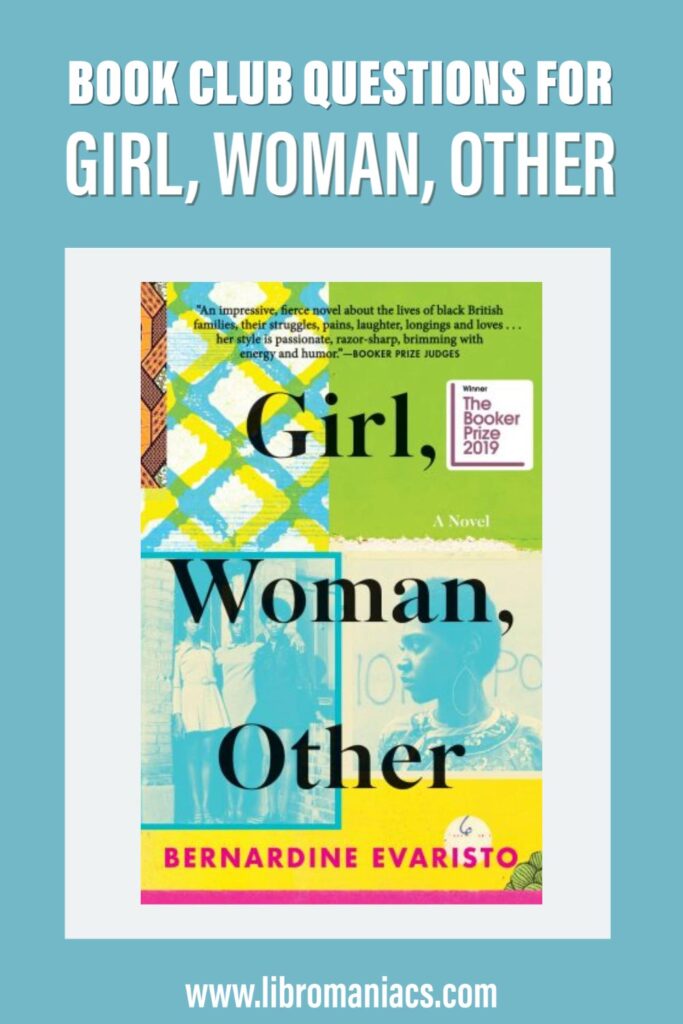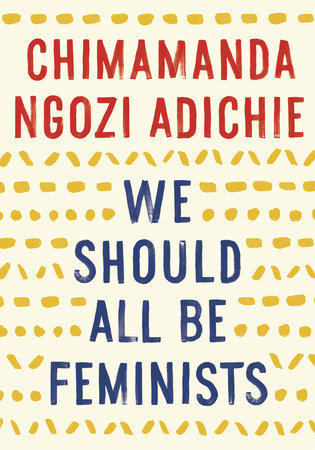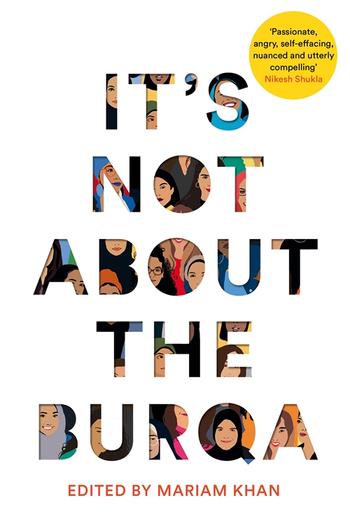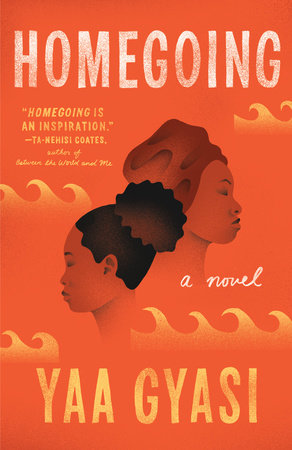Bernardine Evaristo won the 2019 Booker for Girl, Woman, Other, the first Black woman to do so. And if it annoys you that, in the last 20 years, women have only won the Booker 7 times, then I’m sure you were able to appreciate the feminist thread in Evaristo’s book.
(Hey Booker, you can do better.)
Girl, Woman, Other lays bare complicated feminist themes as well as issues of multiculturalism, gender roles, gender fluidity, Lesbian life and painful multi-gen family dynamics. There is certainly no shortage of things to discuss here and our Girl, Woman, Other book club questions will help you get the conversation started.
This discussion guide starts with the publisher’s book synopsis. Did you find it an accurate description of your experience with the book? If not, why?
Following that, move along to our 10 Girl, Woman, Other discussion questions and check out some selected (and thought provoking) reviews of the book.
Then, if you liked the book, we mop up by recommending three books with similar themes.
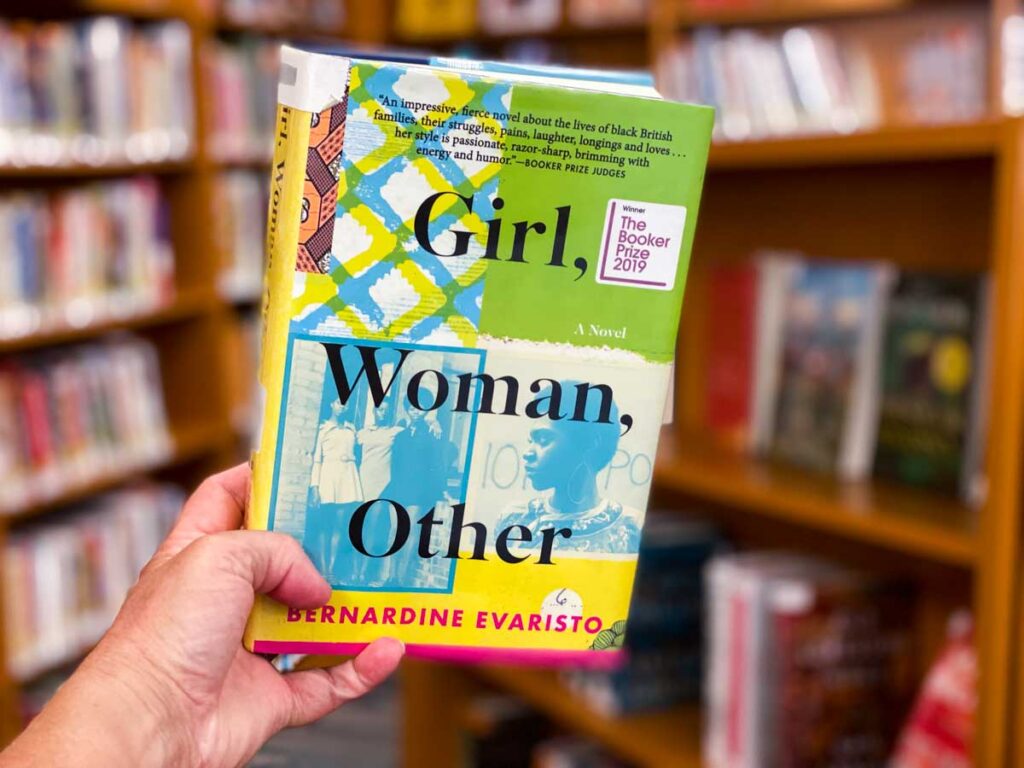
(This article contains affiliate links. This means that if you choose to purchase, I’ll make a small commission.)
Girl, Woman, Other Book Synopsis
Girl, Woman, Other by Bernardine Evaristo
Girl, Woman, Other is a magnificent portrayal of the intersections of identity and a moving and hopeful story of an interconnected group of Black British women that paints a vivid portrait of the state of contemporary Britain and looks back to the legacy of Britain’s colonial history in Africa and the Caribbean.
The twelve central characters of this multi-voiced novel lead vastly different lives: Amma is a newly acclaimed playwright whose work often explores her Black lesbian identity; her old friend Shirley is a teacher, jaded after decades of work in London’s funding-deprived schools; Carole, one of Shirley’s former students, is a successful investment banker; Carole’s mother Bummi works as a cleaner and worries about her daughter’s lack of rootedness despite her obvious achievements. From a nonbinary social media influencer to a 93-year-old woman living on a farm in Northern England, these unforgettable characters also intersect in shared aspects of their identities, from age to race to sexuality to class.
Sparklingly witty and filled with emotion, centering voices we often see othered, and written in an innovative fast-moving form that borrows technique from poetry, Girl, Woman, Other is a polyphonic and richly textured social novel that shows a side of Britain we rarely see, one that reminds us of all that connects us to our neighbors, even in times when we are encouraged to be split apart.
10 Girl, Woman, Other Book Club Questions
- Evaristo uses punctuation in the title, but then makes spare use of it within the book. There is often a lack of periods and commas, but question marks and dashes seem to be in rotation. Did you notice the lack of punctuation? What do you think Evaristo was trying to do with that choice?
- The book also jumps through time and between different character stories. How did you find the format? Were you able to follow the threads?
- There is a vast amount of multiculturalism happening in the book. The characters are from St Lucia, Nigeria, Barbados and Malawi with Afro-Guyanese mothers, half caste’s from Aberdeen, the Egyptian Elite and a Somali Muslim. These women are so very not the stereotypical British white bread. What did those different points of view tell you about current British demographics and culture?
- There is a lot of multigenerational tension happening in the book. Each generation has a different point of view regarding feminism, gender roles, sexuality and culture. How does this play off between the characters, such as between Amma and her daughter Yazz, Megan/Morgan and her mother Harriett, between Bummi and Carole and so on?
- Yazz’s mother Amma “…wondered if she really was still being brainwashed by white society, and whether she really was failing at the identity she most cherished- the black feminist one.” What are some of the ways that you saw Amma (or any of the other characters) working hard at her/their identity as feminists of color?
- Shirley’s mother Winsome launches an interior critical dialogue about Shirley, who she considers “…never satisfied with what she has: excellent health, cushy job, hunky husband, lovely daughters and granddaughter, good house and car, no debts, free luxury holiday in the tropics every year. Tough life Shirl.” And yet, Winsome betrayed Shirley in a most profound way. What did you think of that betrayal and the relationship between Shirley and Winsome?
- Carole’s rape as a teenager has such a profound effect on the rest of her life. At an outward glance, her acceptance of Shirley’s help and her steely focus helped her to become a very successful businesswoman. But she remains angry, and has left her Nigerian culture behind. What did you think of her journey?
- “Nzinga was a teetotal, vegan, non-smoking, radical feminist separatist lesbian housebuilder, living and working on wimmin’s land all over America before moving in, a gypsy housebuilder.” but Dominique was a “drinking, drug-dabbling, chain-smoking lesbian feminist carnivorous clubbed who produced theatre by women and lived in a London flat.” How on earth did they even get together? What did you think of their relationship and Nzinga’s abuse?
- “Very small children don’t care about skin colour, Rachel, until they’re brainwashed by their parents”. Think about your own childhood. In what ways were you brainwashed by your parents?
- “We should celebrate that many more women are reconfiguring feminism and that grassroots activism is spreading like wildfire and millions of women are waking up to the possibility of taking ownership of our world as fully-entitled human beings…” Are you a feminist? How do you define it and what does it mean to you?
Selected Girl, Woman, Other Book Reviews
This panoramic, polyphonic novel reflects the lives of (mostly black) women in Britain, and its narrative approach could be described as literary docu-fiction”
“Twelve individual and distinctive voices all vibrating the same responsive web. Initially, I was a little dubious about the absence of punctuation as if it was nothing more than a gimmick but soon the expanses of white space on every page began to seem like open windows allowing in fresh air.”
“Besides racism, the crushing aspirations and dreams of family resting on many of the narrators, is a common theme. The contrast between metropolitan London life and country life…is an other. Unwanted sexual attention and pregnancies, and the impact this always has on women, and almost never men, also comes back a lot. These themes could make this book heavy or tedious even, but Evaristo makes it a joyous, fun, sexual and racially diverse amalgamation of women’s lives.”
“I seriously struggled with the execution of this. First, any individual story reads like a long read article from “The Guardian”. It is sketchy, aspirational, it might be a good journalism. But I am not sure it is a good literature…At minimum I want a complex, human characters. I want depth. Here, the diversity prevail over complexity. The breadth prevails over the depth.”
“I’m sorry, but life is simply too short for this sort of thing. No story, no structure, not even any punctuation, except for commas, and certainly, god forbid for being so straight-laced, no capital letters to mark the beginning of a sentence! No characters that one wants to get to know, no note-worthy prose, no clear conflict that might be resolved. Not a novel.”
3 Books Like Girl, Woman, Other
The Booker Prize that Evaristo got for this book was controversial because in an unprecedented move, the Booker also co-awarded to Margaret Atwood for The Testaments. You could also read that it next and then have a discussion about which book you preferred and whether the Booker was right to split the prize. Here’s our book club guide for The Testaments.
Or you can also look into other Booker nominees like, Klara and the Sun (Kazuo Ishiguru) or Small Things Like These (Claire Keegan).
If you are keen to read more books where the primary character is a woman of color, then check out our reading guide for Such a Fun Age or our Maame discussion guide. If you are interested in how race and class play out in the US, check out Isabel Wilkerson’s Caste. We also have a guide for the multi-gen story presented in The Revisioners.
Here are some additional reads for you:
We Should All Be Feminists
by Chimamanda Ngozi Adichie
In this short 64 page read, Adichie offers a new definition of feminism for the 21st century. She’s trying to update the conversation, get away from the tired old bra-burning trope and bring more reluctant folks into the fold.
This is a good read if your book club needs a break from long books. It would also be a good shared read for friends and family members who need to stop dissing feminism and start embracing it.
It’s not About the Burqa: Muslim Women on Faith, Feminism, Sexuality and Race
by Mariam Khan
In Anglo western culture, the Burqa is one seriously misunderstood piece of cloth. The assumed submissiveness that western culture applies to the women who choose to wear a Burqa, severely diminishes Muslim women’s voices.
This essay collection aims to change that. 17 Muslim women speaking frankly about the hijab and wavering faith, about love and divorce, about feminism, queer identity, sex, and the twin threats of a disapproving community and a racist country.
The book will completely crack open any stereotypes you may have about Muslim women.
Homegoing
by Yaa Gyasi
If you want more stories from women of color and/or you liked the polyphonic device of multiple storylines, then you should definitely read Homegoing.
It’s an Oprah book pick and a Pen/Faulkner award winner. The book covers the 250 year history of two half-sisters who were born on Ghana’s Gold Coast, which was a major export center for slaves to the United States. The book’s format is like a family tree of subsequent generations, and the book illustrates how the legacy of slavery plays out across history, both for the enslaved and for those complicit in the slave trade.
Have a listen on Audible. Try audio books for free for 30 days.
Share this Girl, Woman, Other discussion guide on Pinterest:
